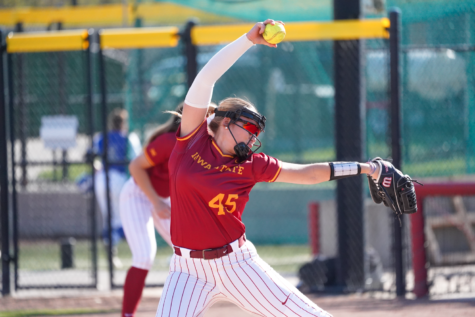A new approach
October 10, 2006
Editor’s Note: This is the first story in a three-part series reflecting on the
one-year anniversary of Athletic Director Jamie Pollard’s hiring
The sports world moves incredibly fast, and Jamie Pollard has no intention of slowing it down.
He might just speed it up a little more.
Pollard, athletic director at Iowa State, has just celebrated his one-year anniversary at the university. He replaced former ISU athletic director Bruce Van De Velde on Oct. 1, 2005, and, although fans, coaches and athletes have already felt his initial presence, it won’t be the last time they do.
Van De Velde, who had been athletic director since 2000, resigned abruptly in early August 2005. It didn’t take Iowa State long to find his replacement – Pollard, who had previously served as deputy athletic director at the University of Wisconsin-Madison. He entered with lofty goals and raised some eyebrows while listing some main points he hoped to achieve quickly.
He immediately wanted to improve communications, improve overall competitiveness of the athletic programs at Iowa State, increase the Cyclone financial resource base and create a fun environment for fans and students at games.
A little more than a year later, Pollard said he’s happy with where the athletic department has gone.
“We’ve progressed as an athletic department at a much quicker pace than I expected us to be at this time,” Pollard said.
“We certainly have a long, long ways to go, but a lot of really good things have happened to this department and to our fan base, and that’s exciting because it gives us hope.”
It wasn’t necessarily easy to get to that point, however.
Shortly after taking his post as the head of Cyclone athletics, Pollard reorganized the structure of his assistant athletic directors and set his sight on the biggest goal of the program – one that’s haunted every athletic director who has spent time at Iowa State. Arguably his biggest goal is to try and raise the budget from the Big 12’s lowest – $28 million – and increase it to a level where the Cyclones can be continually competitive in the Big 12.
The plan was to attack on all fronts. The athletic department was to aggressively pursue boosters, ticket sales and media outlets, the biggest of which was inking a seven-year contract with media communications specialist Learfield Sports. That instantly raised Iowa State’s budget from $28 million last year to $34 million this year.
While negotiations with communication companies were well under way, another task was staring Pollard straight in the face – expanding the fan base.
The process started by releasing an open document to all fans, titled “Taking the Next Big Step,” in which Pollard relayed the future of ISU athletics. In the letter, he explained the department’s thought process behind ticket prices, donation levels and other financial aspects of the department.
“That was our way of communicating what a lot of people had already started to feel,” Pollard said. “We’re striving to do more.”
So far, it’s worked.
“I think we’ve done a really, really good job in changing how we communicate with fans,” Pollard said. “We’ve been really proactive.”
He just kept rolling along, too, as another immediate goal of his – changing the overall gameday atmosphere – has progressed during the last year. The changes so far include $99 season football tickets in the endzone, a new entrance through an inflatable helmet for the football team, “Cyclone Warning” sirens that sound before every football game, new cheers implemented and renovations to Hilton Coliseum, including a new scoreboard and videoboard.
Pollard’s plan has already been noticed around Cyclone Nation, including by 12-year coaches Bill Fennelly (women’s basketball) and Dan McCarney (football).
“He has a tremendous vision, one that he wants to see come about more sooner than later,” Fennelly said. “It’s going to really, really be special. The scoreboard is a monster. He took a great home-court advantage and made it even better.”
The changes, which are already evident at football games, have been received well by fans.
“The biggest change in the stadium atmosphere has been the students, hands down,” Pollard said.
“They’ve gotten into the cheers, and it’s been fun to watch that. We’ve got a home-field advantage now.”
McCarney has been happy with them, as well.
“I walked out there the other day. I spoke to recruits and I opened the gates and an avalanche of students came running from the gates,” he said. “It’s all part of trying to continue the tradition.”
Still, it’s too early to tell if the fans’ response is real commitment or simply over-excitement. In the short run, though, the Cyclone fans have responded. In addition to breaking the season ticket sales record – more than 30,000 sold this season – fans have set the single-game attendance record against Northern Iowa on Sept. 30, with 55,518 fans in attendance.
All together, the response has been nearly overwhelming, but the athletic department staff can’t afford to let it end there.
“Time will tell over the long haul,” Pollard said. “From the tickets standpoint, we’re up, but from the donations, we won’t really know until next year. We’ll be repricing the donation levels and the new suites.”
















